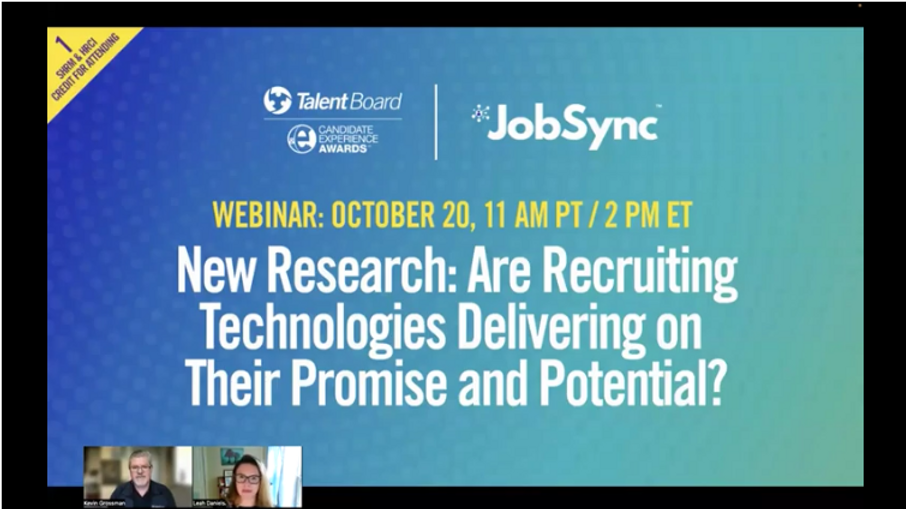
JobSync and Talent Board partnered to uncover the relationships that hiring teams have with their technology integrations. Which parts of their tech stack make their lives easier? What keeps teams from adopting new technologies? Where should investments be made to improve both the candidate and recruiter experience?
Leah Daniels, CCO of JobSync sat down with Kevin Grossman, President of the Talent Board to discuss the findings. Watch the full replay here.
Hiring is finally at the forefront of an organization’s priorities and companies have started to realize the investment that needs to be made for their hiring teams to be successful.
“Hiring is no longer something that is just buried in the organization.” – Leah Daniels
According to Aptitude Research 73% of companies are investing more in their recruiting technology. What they are not doing though, is hiring more recruiters. They are throwing more technology at the problem or they are having junior level or non-recruiters help with the processes. And, that continues to slow things down. The big question then becomes, “what is the point of investing in new technologies if you are not going to properly utilize them in the best way possible?”
We’ve seen an explosion of new technologies over the last few years.
Take one look at the Talent Technology Ecosystem. The abundance of technology options to choose from is overwhelming. From sourcing, to developing, to hiring and onboarding – the options seem endless. With 18 billion invested in 2021 and over 9 billion in the first half of 2022, the investment in talent-centric technologies isn’t slowing. How can companies filter through to decide which technologies will have a demonstrable impact on their specific recruiting process?
Companies cannot seem to save time on hiring, even as they add technology to their stacks at an ever increasing rate and cost, all with the hope of making recruiters’ lives easier and improving their hiring outcomes. When that tech does not work harmoniously together, however, the benefits are limited.
New recruiting technologies often originate at small companies with a singular focus to solve a specific problem they have uncovered in the industry. With limited knowledge and resources, they develop this solution and begin to sell it to the companies that have this exact problem. The predicament quickly becomes that the solution solves for that specific problem, but is not scalable or congruent with the rest of the market’s approach to recruiting and hiring.
No two companies have the same regimen when it comes to hiring. The needs of recruiters, hiring managers, and HR vary, often driven by the type, structure, past, expected future, and other key and somewhat immovable corporate elements. What healthcare organizations need will not be the same as what a tech startup needs. Although companies need different options, they have one thing in common – the need for the solutions they buy to fit within the organization and process they have. Companies shouldn’t be expected to change their process to fit the solution. That means a great deal of empathy is needed from the vendors, and realization that one-size-fits-all solutions are often one-size-fits-none. Companies need bespoke solutions.
“Your particular recruiting process is bespoke even inside a standardized system.” – Leah Daniels
Bespoke integrations are hard to build and implement, and are often pricey. Many of the integrations and solutions that tech vendors bring to market are intended to replace what has been offered to companies previously. But, the new and old solutions bring the same challenges to companies, they aren’t scalable within the existing technology ecosystem at the company. Technologists are fixated on this idea that you build it once, and deploy it a thousand times. The integration is an afterthought; it’s not a primary driver of their solution.
However, to the recruiter, integration may be the primary driver of the solution. Without an integration that harmoniously connects the new solution to the existing technology, users may never login. With a mediocre integration, the return on investment may not be valuable enough to demonstrate the success of the solution. And, while a lot of the pressure is on the point solution provider, much of the integration gap is a result of the limitations of the primary systems. ATSs are often the biggest proponents of the “build it once, use it a thousand times” or stated differently, the “standard equals easier to support” philosophy.
“The solution cannot fit the solution provider’s vision, it has to fit the users’ vision.” – Leah Daniels
Hidden inside this conversation is “What does integration mean?” For technologists, it is typically as simple as this data field maps to that data field. Point-to-point. But to practitioners, it means “Make it work for me”. “Work for me” isn’t a fixed and rigid integration – it’s flexible, adaptable, and automates the process that exists. But integration and automation do not always play well together. In fact, they are often on opposite sides of the same coin.
Automation is a result of process; integration is the result of technology.
This leads to one of the biggest takeaways of the joint report: recruiters are still doing a shocking amount of manual work. 61% spend more than 6 hours a week doing manual tasks. Why? The data tells us that 53% of respondents still find their ATS both their most important technology and the least easy to integrate. This flies in the face of the proliferation of integration marketplaces that each and every major ATS touts.
Another hurdle thrown into the hiring process for companies making a new investment is that technology should be the solution. What they don’t factor in is the learning curve for new users, the process change to adapt to new systems, and the automation layers required to make it all work together.
What is one of the biggest challenges to integrating new technology?
According to the survey respondents, 36% said their biggest concern with bringing new technology on board is the integration with their legacy systems. Will they work well together? Will it require more manual work or actually save time?
When a company chooses an ATS they are in for the long haul, sometimes ten years plus. How can they adapt to the future changes in the ecosystem and the demand of the market? Most systems today have marketplaces of vetted integrations – but most of those integrate, they don’t automate.
The goal is to find solutions that do the following:
Work within your existing process and systems
Drive logical change within your existing processes
Find solutions that marry the goal of the point solution to the processes and systems you already have in place
Remember, your tech should enhance your processes, not add more work for your recruiters or just exist alongside your current technology.


